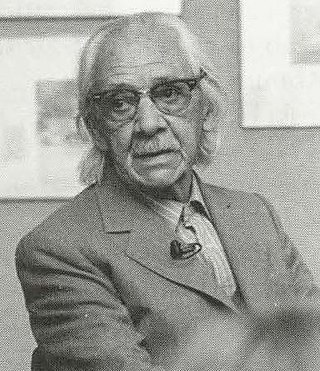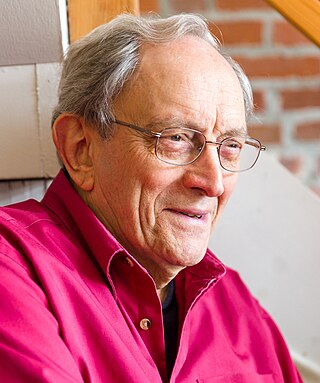
Elizabeth "Lee" Miller, Lady Penrose, was an American photographer and photojournalist. Miller was a fashion model in New York City in the 1920s before going to Paris, becoming a fashion and fine-art photographer there.

André Kertész, born Andor Kertész, was a Hungarian-born photographer known for his groundbreaking contributions to photographic composition and the photo essay. In the early years of his career, his then-unorthodox camera angles and style prevented his work from gaining wider recognition. Kertész never felt that he had gained the worldwide recognition he deserved. Today he is considered one of the seminal figures of 20th century photography.

Ernst Haas was an Austrian-American photojournalist and color photographer. During his 40-year career Haas trod the line between photojournalism and art photography. In addition to his coverage of events around the globe after World War II Haas was an early innovator in color photography. His images were carried by magazines like Life and Vogue and, in 1962, were the subject of the first single-artist exhibition of color photography at New York's Museum of Modern Art. He served as president of the cooperative Magnum Photos. His book of volcano photographs, The Creation (1971), remains one of the most successful photography books ever published, selling more than 350,000 copies.
David Goldblatt HonFRPS was a South African photographer noted for his portrayal of South Africa during the apartheid period. After apartheid's end, he concentrated more on the country's landscapes. Goldblatt's body of work was distinct from that of other anti-apartheid artists in that he photographed issues that went beyond the violent events of apartheid and reflected the conditions that led up to them. His forms of protest have a subtlety that traditional documentary photographs may lack; Goldblatt said, "[M]y dispassion was an attitude in which I tried to avoid easy judgments.... This resulted in a photography that appeared to be disengaged and apolitical, but which was in fact the opposite." Goldblatt also wrote journal articles and books on aesthetics, architecture, and structural analysis.

Manuel Álvarez Bravo was a Mexican artistic photographer and one of the most important figures in 20th century Latin American photography. He was born and raised in Mexico City. While he took art classes at the Academy of San Carlos, his photography is self-taught. His career spanned from the late 1920s to the 1990s with its artistic peak between the 1920s and 1950s. His hallmark as a photographer was to capture images of the ordinary but in ironic or Surrealistic ways. His early work was based on European influences, but he was soon influenced by the Mexican muralism movement and the general cultural and political push at the time to redefine Mexican identity. He rejected the picturesque, employing elements to avoid stereotyping. He had numerous exhibitions of his work, worked in the Mexican cinema and established Fondo Editorial de la Plástica Mexicana publishing house. He won numerous awards for his work, mostly after 1970. His work was recognized by the UNESCO Memory of the World registry in 2017.

Okwui Enwezor was a Nigerian curator, art critic, writer, poet, and educator, specializing in art history. He lived in New York City and Munich. In 2014, he was ranked 24 in the ArtReview list of the 100 most powerful people of the art world.

William Klein was an American-born French photographer and filmmaker noted for his ironic approach to both media and his extensive use of unusual photographic techniques in the context of photojournalism and fashion photography. He was ranked 25th on Professional Photographer's list of 100 most influential photographers.

Samuel Joseph Haskins, was a British photographer, born and raised in South Africa. He started his career in Johannesburg and moved to London in 1968. Haskins is best known for his contribution to in-camera image montage, Haskins Posters (1973) and the 1960s figure photography trilogy Five Girls (book) (1962), Cowboy Kate & Other Stories (1964) and November Girl (book) (1967), plus an ode to sub-saharan tribal Africa "African Image (book) (1967).
Ernest Levi Tsoloane Cole was a South African photographer. In the early 1960s, he started to freelance for clients such as Drum magazine, the Rand Daily Mail, and the Sunday Express. This made him South Africa's first black freelance photographer.

Nadav Kander HonFRPS is a London-based photographer, artist and director, known for his portraiture and landscapes. Kander has produced a number of books and had his work exhibited widely. He received an Honorary Fellowship from the Royal Photographic Society in 2015, and won the Prix Pictet award.
R. Ian Lloyd is an Australian photographer who was born in Canada in 1953 and studied photography at Rochester Institute of Technology and Brooks Institute of Photography in the United States before coming to Australia in 1975. He worked in television and as a photographer for guide books before establishing his own photography and publishing company in Singapore in 1983. Ian has undertaken commissions for magazines such as National Geographic, Fortune and Time, and has won numerous awards for his work. He has photographed 36 books on countries and regions around Asia including large format books on Kathmandu, Bali and Singapore and a four volume series on Australian wine regions. His photographs have been widely exhibited around the world. In 2000 a retrospective book and exhibition of his work, Spirit of Asia, toured six Asian cities under the sponsorship of the National Geographic Channel. In 2007 he produced a book, DVD and travelling exhibition entitled STUDIO: Australian Painters on the Nature of Creativity.

Wayne Forest Miller was an American photographer known for his series of photographs The Way of Life of the Northern Negro. Active as a photographer from 1942 until 1975, he was a contributor to Magnum Photos beginning in 1958.
Anthony Barboza is a photographer, historian, artist and writer. With roots originating from Cape Verde, and work that began in commercial art more than forty years ago, Barboza's artistic talents and successful career helped him to cross over and pursue his passions in the fine arts where he continues to contribute to the American art scene.

Eliot Elisofon was an American documentary photographer and photojournalist.

The participation of women in photography goes back to the very origins of the process. Several of the earliest women photographers, most of whom were from Britain or France, were married to male pioneers or had close relationships with their families. It was above all in northern Europe that women first entered the business of photography, opening studios in Denmark, France, Germany, and Sweden from the 1840s, while it was in Britain that women from well-to-do families developed photography as an art in the late 1850s. Not until the 1890s, did the first studios run by women open in New York City.

Rudolf Eickemeyer Jr. was an American pictorialist photographer, active in the late 19th and early 20th centuries. He was one of the first Americans to be admitted to the Linked Ring, and his photographs won dozens of medals at exhibitions around the world in the 1890s and early 1900s. He was famous among his contemporaries for his portraits of high-society women, most notably model and singer Evelyn Nesbit. Eickemeyer's best-known photographs are now part of the collections of the Smithsonian Institution.
George Hallett was a South African photographer known for images of South African exiles. His body of work captures much of the country's turbulent history through Apartheid and into the young democracy.

John T. Hill is an American artist. His work focuses mainly on design and photography.

Photography in Sudan refers to both historical as well as to contemporary photographs taken in the cultural history of today's Republic of the Sudan. This includes the former territory of present-day South Sudan, as well as what was once Anglo-Egyptian Sudan, and some of the oldest photographs from the 1860s, taken during the Turkish-Egyptian rule (Turkiyya). As in other countries, the growing importance of photography for mass media like newspapers, as well as for amateur photographers has led to a wider photographic documentation and use of photographs in Sudan during the 20th century and beyond. In the 21st century, photography in Sudan has undergone important changes, mainly due to digital photography and distribution through social media and the Internet.

Robert A. Hamblin is a South African-born visual artist, working mainly in photography and paint on paper.














